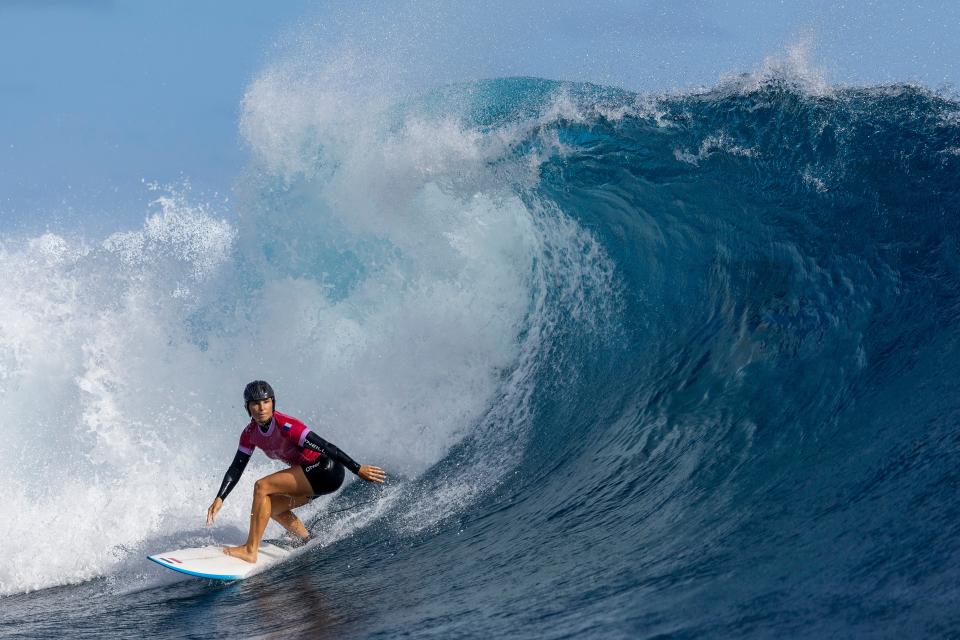Why Some Olympic Surfers Are Wearing Helmets on Tahiti’s ‘Wall of Skulls’

Ed Sloane/Getty Images
The crystal clear waves of the Olympic surfing beach in Tahiti might look like paradise from the comfort of your couch, but drama under the surface of the Pacific is making this year’s surfing competition way more dangerous than you may think.
Across the world from the action in Paris, Olympic surfers are living and competing in the village of Teahupo’o, which ominously roughly translates to “the wall of skulls.” This wave break is considered one of the heaviest (surfer-speak for big, fast, and dangerous) in the world, and for years, many of the world’s top surfers didn’t think the wave was even surfable. The combination of the powerful barreling wave and its proximity to a shallow, sharp reef can be deadly. Teahupo’o has taken five lives, according to The Washington Post. And it’s injured dozens more.
When Olympic kayakers face rapids on a man-made course, they wear helmets and life preservers. Water polo players don ear protection. The most skilled dressage riders strap on a helmet for a ballet-like performance on a flat arena. Yet most surfers facing one of Mother Nature’s most deadly forces wear little more than a rash guard. What gives?
The rules set by the International Surfing Association (ISA) do not require Olympians to wear helmets, but the ISA released a statement recommending protective headwear ahead of this year’s exceptionally dangerous conditions in Paris. Though falling into water might not sound all that scary, the real danger in Teahupo’o comes from the reef. Just below the surfers in Tahiti—usually invisible on the TV broadcast—is a field of coral that can cause serious damage, especially if you hit it with the inertia of a 12-meter wave behind you.
Ultimately, the helmet question is up to the athletes. And unfortunately, as a 2020 study published in International Review for the Sociology of Sport shows—aptly titled “‘Helmets Aren’t Cool’: Surfers’ Perceptions and Attitudes Towards Protective Headgear”—many just haven’t thought it was necessary. According to the study, the surfers believed “uncomfortable” helmets would “hinder the performance of [surfing]” and make them look “uncool” in a sport where aesthetics often matter. But, as the researchers wrote, there’s evidence to support that head protection can be vital for safety. The study notes that “head-related injuries comprise a considerable proportion of surfing injuries.” And head trauma can have severe short- and long-term consequences, including concussion, seizures, and dizziness—not to mention, as the study authors pointed out, the risk of drowning.
Since most surfers don’t wear safety gear during training, it’s natural not to want to change things up on one of the biggest days of their career. However, conditions at this year’s Games may force some athletes to reconsider. French surfer Johanne Defray fell headfirst into the coral on her first training wave on July 28. She avoided a concussion, but needed four stitches, according to USA Today. She wore a helmet during competition on August 1, and it’s probably safe to assume she’ll be sporting one for the remainder of her time in Teahupo’o.
Others concerned about the shallow reef, including Team USA member Caroline Marks (who placed fourth in Tokyo in the women’s shortboard competition and faces Defray in the Olympic semifinals on August 3), have at least packed a helmet for the competition. In an interview with People before the Games, Marks—who said she’s not sure yet if she’ll use it—explained, “It’s obviously not natural to wear a helmet when you’re surfing, so it does take a moment to get used to it.” Still, she said, “it’s great to have the option,” especially since she does think “they have saved a lot of people from getting injured.”
Kauli Vaast, a Tahitian competing for France who regularly trains on Teahupo’o, has the home court advantage. But he’s also all too familiar with the powerful wave. Though he hasn’t been wearing a helmet every day of the competition, he told Stab Magazine in a 2019 interview that he “feels more confident” wearing headgear on heavier waves like Teahupo’o.
As the 2024 surfing competition narrows down to medal matches, we may see more protective headgear on the waves. Weather permitting, the men’s semifinals will kick off at 1:00 pm EST on August 3, followed by the women’s semifinals at 2:12. The bronze and gold medal matches will conclude the Olympic day, and Team USA’s Caroline Marks is in a prime position to bring home some hardware.
SELF is your one-click source for all things Summer Olympics. Read our latest coverage of the Paris Games here.
Related:
The Sweet Reason Track Star Sha’Carri Richardson Does Her Nails
Paris 2024 Was Supposed to Be ‘Normal’—But You Can't Compete With COVID
Track Star (and Musician!) Nia Akins on the Songs That Hype Her Up and Calm Her Down
Get more of SELF’s great sports coverage delivered right to your inbox—for free.
Originally Appeared on SELF

 Yahoo Sports
Yahoo Sports 
